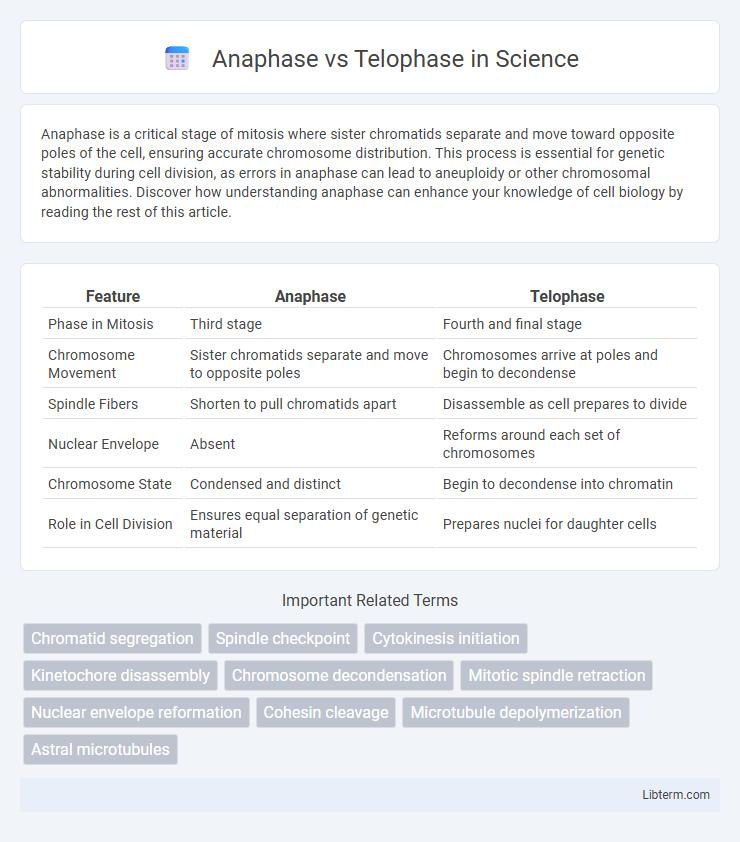Anaphase is a critical stage of mitosis where sister chromatids separate and move toward opposite poles of the cell, ensuring accurate chromosome distribution. This process is essential for genetic stability during cell division, as errors in anaphase can lead to aneuploidy or other chromosomal abnormalities. Discover how understanding anaphase can enhance your knowledge of cell biology by reading the rest of this article.
Table of Comparison
| Feature | Anaphase | Telophase |
|---|---|---|
| Phase in Mitosis | Third stage | Fourth and final stage |
| Chromosome Movement | Sister chromatids separate and move to opposite poles | Chromosomes arrive at poles and begin to decondense |
| Spindle Fibers | Shorten to pull chromatids apart | Disassemble as cell prepares to divide |
| Nuclear Envelope | Absent | Reforms around each set of chromosomes |
| Chromosome State | Condensed and distinct | Begin to decondense into chromatin |
| Role in Cell Division | Ensures equal separation of genetic material | Prepares nuclei for daughter cells |
Introduction to Cell Division
Anaphase and Telophase are crucial phases in mitotic cell division, where Anaphase involves the separation of sister chromatids towards opposite poles, ensuring equal genetic distribution. Telophase follows by re-establishing the nuclear envelope around the separated chromosome sets, initiating the formation of two distinct nuclei. These stages collectively ensure accurate chromosome segregation and cell division completion during mitosis.
Overview of Mitosis Phases
Anaphase is a crucial phase of mitosis where sister chromatids separate and move toward opposite poles of the cell, ensuring accurate chromosome segregation. Telophase follows anaphase, characterized by the reformation of the nuclear membrane around each set of separated chromosomes, marking the near completion of cell division. Together, anaphase and telophase coordinate the physical separation of genetic material and prepare the cell for cytokinesis, the final step in mitosis.
What Is Anaphase?
Anaphase is a critical phase of mitosis where sister chromatids separate and move toward opposite poles of the cell, ensuring equal distribution of genetic material. During anaphase, spindle fibers shorten, pulling chromatids apart to opposite ends, which prepares the cell for division. This process guarantees accurate chromosome segregation, preventing genetic disorders or cell malfunction.
What Is Telophase?
Telophase is the final stage of mitosis where chromosomes arrive at opposite poles of the cell and begin to decondense, forming distinct chromatin. During telophase, the nuclear envelope re-forms around each set of chromosomes, creating two separate nuclei. This phase marks the near completion of cell division, preceding cytokinesis that physically splits the cytoplasm into two daughter cells.
Key Differences between Anaphase and Telophase
Anaphase is characterized by the separation and movement of sister chromatids toward opposite poles, driven by spindle fibers shortening. Telophase follows, marked by the reformation of the nuclear envelope around each set of chromosomes and the decondensation of chromatin. These distinct stages ensure accurate chromosomal segregation and the preparation for cytokinesis in mitotic cell division.
Chromosome Behavior in Anaphase vs Telophase
During anaphase, sister chromatids separate at the centromeres and are pulled toward opposite poles of the cell, driven by spindle fibers shortening. In telophase, the chromosomes arrive at the poles and begin to decondense, transforming from compact structures back into chromatin. This transition marks the preparation for nuclear envelope reformation and the end of chromosome movement.
Structural Changes in Cell during Each Phase
During anaphase, sister chromatids separate and move toward opposite poles of the cell as spindle fibers shorten, causing the cell to elongate. In telophase, separated chromatids arrive at the poles, nuclear membranes re-form around each set of chromosomes, and the chromosomes begin to decondense into chromatin. Cytokinesis often begins during telophase, where the cytoplasm divides, resulting in two distinct daughter cells.
Importance of Anaphase and Telophase in Genetics
Anaphase is crucial in genetics because it ensures the accurate separation of sister chromatids, preventing genetic disorders by maintaining chromosome number integrity during cell division. Telophase plays a vital role in re-establishing the nuclear envelope around the separated chromatids, allowing for the formation of two genetically identical nuclei essential for cellular function and genetic consistency. Together, these phases guarantee proper genetic material distribution, critical for organism growth, development, and heredity.
Common Errors during Anaphase and Telophase
Common errors during anaphase include improper chromosome segregation and lagging chromosomes, which can lead to aneuploidy or genetic instability, while during telophase, errors often involve incomplete nuclear envelope reformation and failure in cytokinesis. Misregulation of spindle checkpoint proteins during anaphase may cause premature chromatid separation, whereas defective chromosomal decondensation in telophase impairs the restoration of interphase nuclei. Accurate coordination of microtubule dynamics and nuclear membrane assembly is crucial to prevent cell division abnormalities during both phases.
Summary: Comparing Anaphase and Telophase
Anaphase is characterized by the separation of sister chromatids as they are pulled toward opposite poles of the cell, ensuring equal genetic distribution. Telophase follows with the reformation of nuclear membranes around the separated chromatids, now distinct chromosomes, and the initiation of cytokinesis to divide the cytoplasm. Together, these phases finalize the physical separation of genetic material and prepare the cell for complete division into two daughter cells.
Anaphase Infographic

 libterm.com
libterm.com